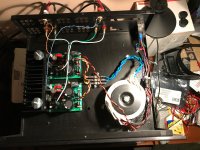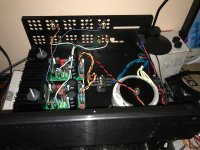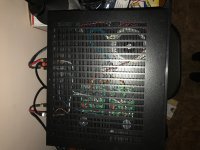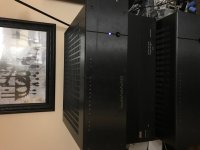I haven't read all 4,500 of the posts, but......
Why in the world would anyone use an LM318 in this day and age? There are MUCH better opamps that have been produced in the last 40 years since the 318's introduction.
Why in the world would anyone use an LM318 in this day and age? There are MUCH better opamps that have been produced in the last 40 years since the 318's introduction.
I haven't read all 4,500 of the posts, but......
Why in the world would anyone use an LM318 in this day and age? There are MUCH better opamps that have been produced in the last 40 years since the 318's introduction.
Um...because it sounds good? Have you heard this amp?
If you're interested in newer, "better" opamps, visit the FE edition thread, where extensive testing is underway with alternatives. There might be better, there might not.
Are there any other old parts that perform better than their newer iterations? Why should we care if a part is 40 years old if it still sounds good?
Peace,
Tom E
I haven't read all 4,500 of the posts, but......
Why in the world would anyone use an LM318 in this day and age? There are MUCH better opamps that have been produced in the last 40 years since the 318's introduction.
The amp is based on, or at least heavily inspired by, the Musical Fidelity A370, designed by Tim de Paravacini. It uses the LM318s, and has a great reputation, so it's a sound choice. There are better op-amps of course, I've fitted ADA4627s and it does indeed sound comfortably better, but it soundedvery good before.
I haven't read all 4,500 of the posts, but......
Why in the world would anyone use an LM318 in this day and age? There are MUCH better opamps that have been produced in the last 40 years since the 318's introduction.
Read least the beginning of the thread where mauropenasa explaining why he chose the LM318. The amp sounds as good as your recordings and your speakers allow it.🙂
The amp is based on, or at least heavily inspired by, the Musical Fidelity A370, designed by Tim de Paravacini. It uses the LM318s, and has a great reputation, so it's a sound choice. There are better op-amps of course, I've fitted ADA4627s and it does indeed sound comfortably better, but it soundedvery good before.
Read least the beginning of the thread where mauropenasa explaining why he chose the LM318. The amp sounds as good as your recordings and your speakers allow it.🙂
There may be newer and - according to datasheets - probably better OPamps but since they sound very good and it's a proven design AND the LM318 is still available for a reasonable price, I don't see why there's the need to swap it for anything else. The design allows to swap it, so you could experiment with that at any time very easily as long as the OP is socketed. The circuit is designed for the LM318 for certain reasons though and I doubt a swap will get you much gain but probably rather losses. Nevertheless, it's definitely worth experimenting with the OP since there definitely are developments on OPs and you could always go back to the original OP anyway.
I noticed that in the first version Mauro shared, the resistors in the bridge were all 10k. But subsequently they were all changed to 22k and 47k. What does it change?
(I ask because I had to change the resistor values from the matched set I got from Linuxguru… 20K : 56K I think) but my other channel still has the old ratios (22K : 47K).
(I ask because I had to change the resistor values from the matched set I got from Linuxguru… 20K : 56K I think) but my other channel still has the old ratios (22K : 47K).
the resistors set up the current multiplication ratio.
for all 10000ohms the current ratio is 1:1
for 22000 with 47000 the ratio is 1:2.13636
and for 20000 with 56000 the ratio is 1:2.8
for all 10000ohms the current ratio is 1:1
for 22000 with 47000 the ratio is 1:2.13636
and for 20000 with 56000 the ratio is 1:2.8
Last edited:
Questions about the power supply.
1) In the well documented Pass Labs build guides, they show CL-60's and a 0.0033uF capacitor used on the mains to the transformer. Is that necessary? If so, what kind of Cap should I use, so I can find it at Mouser/Digikey?
I bought a Antek 2222 (2x22 - 200 watt), I read a soft start is needed for 300watt+, so does that go for the CL-60's and Cap too (can I omit)?
I went back through this thread and didn't see any clear pictures showing CL-60's or a capacitor, but most pics weren't focused on the power supply enough to be 100% sure.
1) In the well documented Pass Labs build guides, they show CL-60's and a 0.0033uF capacitor used on the mains to the transformer. Is that necessary? If so, what kind of Cap should I use, so I can find it at Mouser/Digikey?
I bought a Antek 2222 (2x22 - 200 watt), I read a soft start is needed for 300watt+, so does that go for the CL-60's and Cap too (can I omit)?
I went back through this thread and didn't see any clear pictures showing CL-60's or a capacitor, but most pics weren't focused on the power supply enough to be 100% sure.
You can safely ignore the soft-start. It's totally optional for my_ref requirements. 2 x 22 @ 200W is on the lower side for a my_ref dual channel. It may work just fine as long as you don't plan a full blast volume.
Not sure if 22Vac will cause trouble into the speaker-protection relay to click in.
Not sure if 22Vac will cause trouble into the speaker-protection relay to click in.
Well I finally got this little "beast" put together and working. Couple pics attached (not sure why some are one way preview and turned pulled up, oh well.).
ONE PROBLEM - I get a hum and about 0.5 VAC on the speaker terminals if I don't have anything plugged into the RCA's. Is that normal on a chip amp? This is my first LM3886 amp, but have a IRS2092 (eBay) a ADCOM and B&K Class AB amps and they are all silent without RCA's plugged in.
I measured 1.0mVDC on the left speaker terminals and -3.7mV on the right speaker terminals (w digital DMM)
I played it for 10-15 mintues 3 times on Tuesday/Wednesday making sure it was stable and not over-heating. Last night I let it play for over an hour, without any issues. Chips stay at or below 80-degrees F, heatsink is room temperature, about 75-degrees F. Even the caddock resistors, which have a huge heatsink only get to 90-dgrees. The 2w resistors only show 80-degrees. So I don't see any performance/heating issues, so it must be wiring problem.
It plays just fine and is a very nice sounding amp. As long as the RCA's are plugged in, there is very little hum (have to have ear on the speaker to hear anything) with both a laptop playing Spotify/Pandora, or a iPhone playing Pandora or iTunes. I can pause either device and there is very little hum.
I have tried moving wires to see if that helps, but I can't get any change in sound or loudness. I did verify that although the return for the RCA is isolated from the rear panel (plastic washer), it still has continuity with the IEC ground point. Is that right? The RCA return goes back to the PCB, but the heatsink, RCA returns and PCB mouting screws all show continuity with the IEC ground bolt?
ONE PROBLEM - I get a hum and about 0.5 VAC on the speaker terminals if I don't have anything plugged into the RCA's. Is that normal on a chip amp? This is my first LM3886 amp, but have a IRS2092 (eBay) a ADCOM and B&K Class AB amps and they are all silent without RCA's plugged in.
I measured 1.0mVDC on the left speaker terminals and -3.7mV on the right speaker terminals (w digital DMM)
I played it for 10-15 mintues 3 times on Tuesday/Wednesday making sure it was stable and not over-heating. Last night I let it play for over an hour, without any issues. Chips stay at or below 80-degrees F, heatsink is room temperature, about 75-degrees F. Even the caddock resistors, which have a huge heatsink only get to 90-dgrees. The 2w resistors only show 80-degrees. So I don't see any performance/heating issues, so it must be wiring problem.
It plays just fine and is a very nice sounding amp. As long as the RCA's are plugged in, there is very little hum (have to have ear on the speaker to hear anything) with both a laptop playing Spotify/Pandora, or a iPhone playing Pandora or iTunes. I can pause either device and there is very little hum.
I have tried moving wires to see if that helps, but I can't get any change in sound or loudness. I did verify that although the return for the RCA is isolated from the rear panel (plastic washer), it still has continuity with the IEC ground point. Is that right? The RCA return goes back to the PCB, but the heatsink, RCA returns and PCB mouting screws all show continuity with the IEC ground bolt?
Attachments
The offset on the speakers is supposed to be measured with the inputs shorted. Are you sure that the hum is not actually from your source connected to the inputs? This amp is totally silent with the inputs shorted. The audio ground is separated from the common ground by 1ohm resistors. Is your source connected to the audio ground or the common ground?
PS: initially there was some recognition of the fact that this is more of an LM318n amp than a LM3886 amp 🙂
PS: initially there was some recognition of the fact that this is more of an LM318n amp than a LM3886 amp 🙂
Remember - I am fairly new at this and still learning to read schematics.
Yes - I have the RCA's connected to the Input +/- on the PCB and R11 is populatd with a 1ohm resistor on the PCB.
To short the input, can I use a alligator-clip lead and connect to the center and barrell? Or do I need to modify an actual RCA plug to act as a short? Seems it's the same, but want to make sure before I do any damage.
I'm almost certain it's not from the source, because if the RCA's are plugged into a source, there is no hum (have to have ear on speaker to hear anything) with nothing playing, or music on pause. I only get hum, if I have nothing plugged into the RCA inputs on the amplifier. Not loud enought to cause damage to speakers, but can be heard from 15 feet away in a quiet room.
My source is a laptop with a SMPS brick on a different circuit and the iPhone is running off it's internal battery, so don't think that is the issue either.
Yes - I have the RCA's connected to the Input +/- on the PCB and R11 is populatd with a 1ohm resistor on the PCB.
To short the input, can I use a alligator-clip lead and connect to the center and barrell? Or do I need to modify an actual RCA plug to act as a short? Seems it's the same, but want to make sure before I do any damage.
I'm almost certain it's not from the source, because if the RCA's are plugged into a source, there is no hum (have to have ear on speaker to hear anything) with nothing playing, or music on pause. I only get hum, if I have nothing plugged into the RCA inputs on the amplifier. Not loud enought to cause damage to speakers, but can be heard from 15 feet away in a quiet room.
My source is a laptop with a SMPS brick on a different circuit and the iPhone is running off it's internal battery, so don't think that is the issue either.
Don't short anything!
There are two woes coming from rca. One goes to the LM318 via a 1uf cap. The other one goes to the 1 ohm res (not to the the end connected to the common ground). I can share a rough sketch if this is not clear.
There are two woes coming from rca. One goes to the LM318 via a 1uf cap. The other one goes to the 1 ohm res (not to the the end connected to the common ground). I can share a rough sketch if this is not clear.
Also the rca body (outer terminal should not touch the chassis because usually the chassis is connected to the common ground
I think we are saying the same thing, but maybe I'm not saying it clearly. Yes the (+ or center RCA pin) goes to the "top circle" CONN1 to the 1uF Cap and (- or return RCA barrell) goes to the other CONN1 pin, through the 1ohm resistor. So I think it's correct and wired according to the schematic I have.
I will check again tonight, but the RCA shouldn't be touching the chassis, I have used two plastic washers (outside and inside of rear panel) to isolate it.
I will check again tonight, but the RCA shouldn't be touching the chassis, I have used two plastic washers (outside and inside of rear panel) to isolate it.
Attachments
I think we are saying the same thing, but maybe I'm not saying it clearly. Yes the (+ or center RCA pin) goes to the "top circle" CONN1 to the 1uF Cap and (- or return RCA barrell) goes to the other CONN1 pin, through the 1ohm resistor. So I think it's correct and wired according to the schematic I have.
I will check again tonight, but the RCA shouldn't be touching the chassis, I have used two plastic washers (outside and inside of rear panel) to isolate it.
You did everything correctly. It has been reported in the past that with open inputs there is noise however with a source connected or input shorted it should be silent.
Nice reuse of a chassis...
This particular amp has thrown out a lot of best practice and assumptions out of the window (at least in my case). The way it is truly a differential amplifier, the concept of virtual audio ground etc. has surprised me in many ways. I may be attacked for saying this but I have no star ground, no common ground between the cross over (which had its own supply, chassis is totally isolated from any potential, I have no earth connection to anywhere) and this amp has zero issues (so far).
Do you get hum with the inputs shorted? Can you disconnect the inputs from rca and short the inputs close to the pcb and test for hum?
PS: I thought I was late to the party, but I'm glad to see active enthusiasm on this project 🙂
Do you get hum with the inputs shorted? Can you disconnect the inputs from rca and short the inputs close to the pcb and test for hum?
PS: I thought I was late to the party, but I'm glad to see active enthusiasm on this project 🙂
Last edited:
Thanks - I found it on flea-bay for $10 + shipping, had it for a while collecting dust.You did everything correctly. It has been reported in the past that with open inputs there is noise however with a source connected or input shorted it should be silent.
Nice reuse of a chassis...
Do you get hum with the inputs shorted? Can you disconnect the inputs from rca and short the inputs close to the pcb and test for hum?
PS: I thought I was late to the party, but I'm glad to see active enthusiasm on this project
Can I just run a wire from the input + to - and be considered "shorted"? If so, I'll try that tonight as well. I can easily short the connector right at the PCB if that's best.
I thought I was very late to the party, but have received some valuable assistance on this build.
- Home
- Amplifiers
- Chip Amps
- My "audiophile" LM3886 approach




